The fascinating land of pink cherry blossoms, sushi, and manga comics, Japan is a cultural explosion of historic attractions, neon-lit cities, and exquisite mountainous landscapes. Thankfully, this mystical country retains plenty of its ancient charm resulting in an experience of a lifetime.Head to the capital of Tokyo for a spot of shopping, sample authentic Japanese cuisine, and maybe even enjoy a little karaoke. Although famous for its glitz and neon glam, this impressive modern metropolis also has ancient shrines and temples round just about every corner, making the sightseeing a wonderful combination of old and new.Head south to the city of Hiroshima, the country's most famous tourist destination, where thousands of visitors make a pilgrimage to Hiroshima's Peace Memorial Park, taking in the museums and lively city that has emerged triumphantly from the horror of the atomic bomb dropped during World War II. Hiroshima is a must for anybody interested in modern history and is a deeply moving place to visit.Once you have had enough of Japan's cities, visit the countryside and witness picturesque volcanoes, take a dip in the hot springs, and explore the mountainous interior of the islands. Japan is a beautiful country and even in the cities the parks are punctuated with cherry blossom trees and mathematically correct Zen gardens which never cease to amaze foreigners.
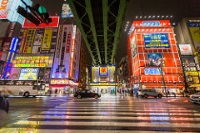
Tokyo's electronic wonderland has become world-renowned. In a small area west of Akihabara Station lies a bright cluster of electronics shops, manga and anime stores, and video game outlets. The suburb has been specialising in electrical equipment since the 1930s and is now regarded as the world's biggest and best electrical equipment enclave. Although the cheap and impressive technology draws many visitors, this is also a paradise for gamers, geeks, and anime and manga fans, with shops full of merchandise and numerous arcades. The arcades carry everything new and novel but also have many of the vintage games that are difficult to find these days. The neighbourhood is a riot of colourful advertising and a fun place to do some people watching, if nothing else. There are a lot of restaurants and fast food joints to try out and some funky eateries. Akihabara is also an entertaining area to stroll around at night, when everything is lit up in neon.
Website : www.akiba.or.jp/english/index.html
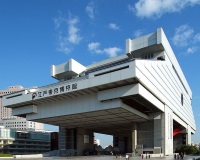
Tokyo's museum dedicated to detailing the city's history, art, culture, and architecture through the medium of visual displays is an impressive attraction not to be missed. Edo was the old name for Tokyo when the country came under the rule of the warlord, Tokugawa Ieyasu. Exhibits include a replica of an ancient Kabuki theatre, maps, photographs, and portrayals of the lives of the city's merchants, craftsmen, and townspeople in days gone by. It is a huge museum which takes a few hours to explore properly and should captivate people of all ages. There are numerous interactive exhibits and many intricate models with such wonderful detail that binoculars are provided for visitors to better appreciate them. Traditional performances are held in the recreated theatre, which is not the only historic building to be recreated life-size. If you are interested in Tokyo's general history then this is the best museum to start with to get an overview of the city's development. Volunteers give regular free tours of the museum and many of them speak fluent English. There is good English signposting and information throughout the museum.
Address : 1-4-1 Yokoami, Sumida-ku
Website : www.edo-tokyo-museum.or.jp
Telephone : +81 3 3626 9974
Opening times : 9.30am - 5.30pm. Saturdays: 9.30am - 7.30pm. Closed on Mondays.
Admission : JPY 600
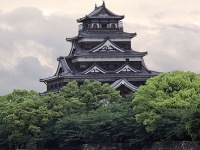
Hiroshima's original castle, built in the late 16th century, was totally destroyed in the atomic blast during World War II but has been reconstructed as a perfect replica. When the castle was established by a feudal lord in 1589, Hiroshima didn't exist; the city that grew around the fortress took its name. At the time, the area was called Gokamura, meaning five small villages, and the lord ruled over a vast territory spanning nine provinces from the stronghold. The castle now houses a museum detailing the region's history up until World War II and particularly the historic feudal system. The exhibits include some models of ancient Hiroshima and the castle and, for those who like playing dress-up, there are even some traditional costumes to try on. The museum is informative and easy to navigate with plenty of information in English. There is a great lookout point at the top of the castle which affords some nice photo opportunities. The grounds are also lovely, housing three trees - a eucalyptus, a willow, and a holly - which survived the bombing in 1945 and endure to this day. One of the most popular tourist attractions in Hiroshima, the castle is definitely worth a visit for anybody with an interest in history.
Address : 21-1 Motomachi, Naka-ku
Website : www.rijo-castle.jp/rijo/main.html
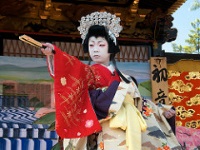
Kabuki is a traditional Japanese dance-drama known for its stylised take of performance and the elaborate make-up worn by some performers. It is a very old art form, which had its golden age in the late 17th and early 18th centuries. Today it is the most popular style of traditional Japanese drama and its star actors can be seen in television and film roles as well as on the stage. While there are many wonderful places in Japan to view Kabuki theatre, the Kyoto Minamiza Theatre is one of the principal venues for such performances and a major hub for the art form. The building itself is an architectural wonder, built in a traditional style in 1929, on the edge of the Geisha district of Gion. Visitors can pay to see individual acts of plays or to see the entire performance. Because the theatre has become popular among tourists, an English voice-over or purchasable programme explains the show to foreigners. A trip to the theatre is a fascinating cultural experience and shouldn't be missed by any tourists with an interest in theatre and Japanese culture. For the uninitiated, one act is generally enough. It is often best to begin with an individual act and then book for a full performance if you enjoy it.
Address : 198 Nakanomachi Yamatooji Nshi-iru, Shijo Ohashi, Higashiyama-ku
Website : www.kabuki-bito.jp/eng/top.html
The composite volcano of Mount Aso lies almost in the centre of Kyushu Island. Among the largest in the world, it's also Japan's biggest active volcano. Mount Aso also boasts one of the world's largest caldera (volcanic depressions), which stretches about 11 miles (18km) from east to west and 15 miles (24km) from north to south. Inside the caldera are five volcanic peaks: Mount Neko, Mount Naka, Mount Eboshi, Mount Taka, and Mount Kishima. Mount Naka is still active and regularly emits smoke and ash. The rest of the landscape inside the caldera is beautifully green and grassy, with grazing cows and horses, as well as about 50,000 inhabitants in several towns and villages. In the city of Aso there is a museum dedicated to the volcano which is worth visiting for those interested in the region's remarkable geology. At the museum visitors can watch presentations about Aso in addition to viewing a live image from a camera positioned at the active crater site. There is a cableway up to the Mount Aso crater lake, called the Mount Aso Ropeway, which allows visitors to see the steaming turquoise water up close. But when the sulphur level rises too high the site is closed as the fumes can become toxic.
The dormant volcano of Mount Fuji, 62 miles (100km) southwest of Tokyo, has been revered since ancient times and no exploration of Japan is complete without visiting the mountain that is known fondly as 'Fuji-san' by the locals. Its symmetrical 12,388-foot (3,776m) snow-crowned summit has become as symbolic of Japan as the country's own flag, featuring in poetry and art through the ages and considered a holy site in Japanese culture. The mountain, which is the highest in Japan, has many historical and mythological associations; for instance, ancient samurai used the base of the mountain as a remote training area, near the present day town of Gotemba. The closest town to the volcano is Fuji Yoshida, from which buses leave frequently for Fuji's 'fifth stage' (the usual jumping-off point for hikes up the mountain) from outside the train station. There are six trails to the summit, of which the Kawaguchiko Trail is the easiest, being quite manageable even for children and the elderly as long as they have stamina and good shoes. Overnight huts are available for those wanting to stay a night or two on the mountain. The official climbing season is from 1 July to the end of August as in winter snow makes the ascent too dangerous.
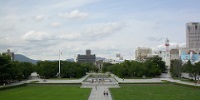
Around the epicentre of the atomic bomb explosion in Hiroshima in 1945, a complex of buildings and monuments has been erected in the Peace Memorial Park to commemorate the earth-shattering event. The park is dedicated to the promotion of world peace. Central to the park is the only remaining city building damaged in the blast; it was formerly the Industrial Promotion Hall, but is now known as the Atomic Bomb Dome and has been declared a UNESCO World Heritage Site. The park also contains the Peace Memorial Museum, featuring exhibits portraying the horrible effects of the bomb on the city and its citizens. Between the museum and the dome stands the Memorial Cenotaph containing a stone chest, inside which is a list of all those killed in the explosion or who died subsequently from the long-term effects caused by radiation. The Cenotaph also houses the peace flame, which will burn until nuclear war is no longer considered a threat to humanity. Other monuments include the Statue of the A-Bomb Children and the Atomic Bomb Memorial Mound containing the ashes of tens of thousands of unidentified victims.
Address : 1-2 Nakajima-cho, Naka-ku
Website : www.pcf.city.hiroshima.jp/index_e2.html
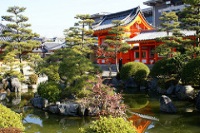
The temple of Rengeoin, in eastern Kyoto, is better known by its popular name of Sanjusangen-do. Inside the longest wooden building in Japan stand row upon row of life-sized statues of Kannon, the goddess of mercy, carved from Japanese cypress and covered in gold leaf, dating back to the 12th and 13th centuries. There are 1,000 statues altogether and each is unique, bearing a religious symbol or making a religious gesture. The statues surround the large, central figure of a seated Kannon, carved in 1254 in the Kamakura Period. The building and statues were once part of a large Buddhist temple complex known as the Lotus King Temple which was sadly destroyed leaving only a few buildings intact. The effect of all the golden statues, which create a kind of yellow haze, is mystical and somewhat hypnotic, giving credence to the local myth that if you stare at them for long enough one of the statues will assume the form of a loved one. No photos are allowed inside but you are permitted to photograph the outside of the building and the lovely grounds. There is a gift shop where you can buy some souvenirs at a reasonable cost. There are guides and prayer books in English for those who want more information.
Address : Shichijo Dori
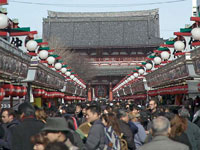
The Asakusa neighbourhood of Tokyo draws visitors to admire the city's oldest temple, Senso-ji, founded in 628 AD with a quaint legend attached to it. The story goes that two young brothers fishing in the nearby river netted a golden image of Kannon, the Buddhist goddess of mercy, and the statue kept turning up in their nets no matter how many times they threw it back. The brothers were inspired to enshrine it in a temple dedicated to the deity. The statuette is still inside, but never shown to the public, though pilgrims flock here every day seeking the favour of the goddess. There are also numerous festivals associated with the shrine, and a hugely popular firework display is held on the Sumida River every summer. Tourists enjoy the visit to the temple mainly because the approach is a colourful pedestrian lane, Nakamise Dori, lined with shops and souvenir stalls. The area has become touristy but it is still a stronghold for ancient traditions and a wonderful place to do some people watching. For many tourists the temple is one of the highlights of a visit to Tokyo; the temple complex is usually bustling with activity and there is lots to see and do. Nearby, the Demboin Garden is a good spot to grab a break from the city crowds.
Address : 2-3-1 Asakusa Taito-ku, Shitamachi (downtown)
Opening times : Main Hall: 6am to 5pm (from 6.30am between October and March). Temple grounds are always open.
Admission : Free
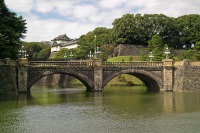
Japan's Imperial Palace is regarded as the heart and soul of Tokyo, standing on a huge site that still bears the remains of Edo Castle, stronghold of the Tokugawa Shogunate. The present palace was completed in 1888 and is still home to the emperor of Japan. The palace is off-limits but its grounds and surrounds provide a much-needed green open space for the city with Higashi Gyoen (East Garden), site of the Edo Castle keep, open to the public. On January 2nd and December 23rd each year, visitors are able to enter the inner grounds and see the Imperial family make public appearances from the balcony. Guided tours of the palace are offered but only in Japanese, although an English pamphlet and audio guide are provided. These tours must be reserved in advance through the Imperial Household Agency. Be sure to take along your passport when you go to reserve a spot. In spring, the gardens are awash with colour when the cherry blossoms are in bloom, particularly along the castle moat. The Imperial Palace is bustling throughout the year, with lots to see including a few small museums, some wonderful landscaping, and many symbolic ornamental touches like the plants from every prefecture dotted around the palace.
Opening times : East Garden is closed on Mondays and Fridays. Otherwise it is open daily 9am-4pm (until 3:30pm between November and February). Gardens closed from 28 December to 3 January and when Imperial Court functions take place.
Admission : Free
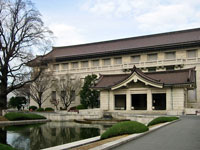
Close to Ueno Station and enclosed in the beautiful, spacious park of the same name, the National Museum is host to the largest collection of Japanese art in the world. Exhibits range from antique kimonos and delicate pottery to woodblock prints and archaeological finds. The vast collection is displayed on a rotating basis with at least 4,000 artefacts visible at any time, so the museum always has something new to offer. The museum consists of five different buildings containing numerous galleries, so one needs sufficient time to do it justice. The Imperial Gift Park is a lovely place to enjoy a stroll, with big ponds and shaded areas to rest; the grounds also contain some other cultural institutions, including a zoo, the Metropolitan Art Museum, Bunka Kaikan Cultural Hall, the Western Art Museum, and the National Science Museum. There should be something here to interest the whole family and all the educational attractions can easily fill a whole day of sightseeing.
Address : 13-9 Ueno Park,Taito-ku
Website : www.tnm.go.jp
Telephone : (0)3 3822 1111
Opening times : Daily 9:30am to 5pm, depending on season; closed Mondays. Closing times vary with the seasons, visitors are advised to check before arrival.
Admission : JPY 620 (adults), JPY 410 (students), free for scholars.
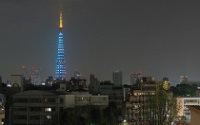
The Tokyo Tower is modelled in the vein of the Eiffel Tower in France, only in true Japanese style, it is more colourful and serves a technological purpose. Tokyo Tower functions chiefly as a television and radio antenna but it is also Tokyo's premier landmark and a proud symbol of Japanese culture, celebrating the country's industrial and technological success. At 1,091 feet (332m) it is the tallest structure in Tokyo and a great vantage point from which to take in the city. There are two observation decks in the tower, both with magnificent 360 degree panoramic views. Admiring the city from this high vantage point is only one aspect of the tourist's experience at the tower, however. At the base of the tower, tucked snugly under its 'legs', is the four-storey FootTown. Inside FootTown visitors will find shops, restaurants, a wax museum, the Guinness Book of World Records Museum, an aquarium, and the Mysterious Walking Zone, a fascinating display of holographic technology and imagery. The top floor of FootTown is an interactive art gallery, featuring optical illusions which can be manipulated by visitors. There is lots to see and do and the Tokyo Tower should delight people of all ages.
Address : 4-2-8 Shiba-Koen, Minato-ku
Website : www.tokyotower.co.jp/english/
Telephone : 03 3433 5111
Opening times : Daily 9am-11pm. The Special Observatory is currently closed for renovations.
Admission : Main Observatory: JPY 900 Adults; JPY 500 junior high and primary school students; JPY 400 children.

Travel Guide powered by Word Travels, copyright © 2023 Globe Media Ltd. By its very nature information in this travel guide is subject to change at short notice and travellers are urged to verify information on which they're relying with the relevant authorities. Neither Globe Media Ltd nor Travel Vogue can accept any responsibility for any loss or inconvenience to any person as a result of information contained above.